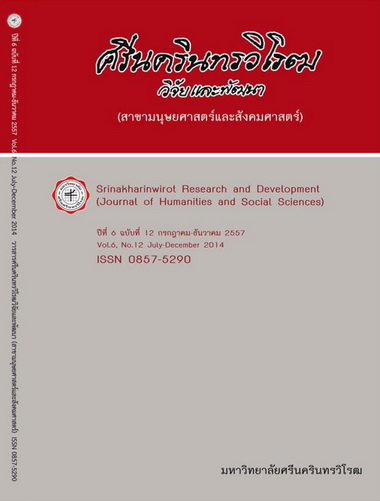ความเข้าใจของนักเรียนชั้นมัธยมศึกษาปีที่ 5 เกี่ยวกับการเขียนแผนภาพรังสีของแสง (ELEVENTH-GRADE STUDENTS’ UNDERSTANDING ABOUT DRAWING LIGHT RAY DIAGRAMS)
Keywords:
Drawing Light Ray Diagram, Geometrical Optics, Misunderstanding, Teaching and Learning Physics, Secondary EducationAbstract
บทคัดย่อการวิจัยนี้มีวัตถุประสงค์เพื่อศึกษาความเข้าใจของนักเรียนชั้นมัธยมศึกษาปีที่ 5 เกี่ยวกับวิธีการ หลักการพื้นฐาน และข้อจำกัดของการเขียนแผนภาพรังสีของแสง เพื่อบรรยายและอธิบายการเกิดภาพจากกระจกโค้ง พลวิจัยเป็นนักเรียน 5 คน ซึ่งได้รับการคัดเลือกแบบจำเพาะเจาะจง เครื่องมือในการสร้างข้อมูลประกอบด้วย แบบทดสอบและการสัมภาษณ์แบบกึ่งโครงสร้างรายบุคคล คณะผู้วิจัยตีความและวิเคราะห์ข้อมูล ทั้งโดยลำพังและโดยกลุ่ม เพื่อหาแบบแผนของความเข้าใจของพลวิจัย ผลการศึกษาแสดงว่า พลวิจัยทุกคนสามารถเขียนแผนภาพรังสีของแสง โดยใช้วิธีการที่สอดคล้องกับวิธีการในแบบเรียน แต่ไม่เข้าใจหลักการพื้นฐานและข้อจำกัดของการเขียนแผนภาพรังสีของแสง ผลการศึกษานี้ให้ข้อมูลที่มีประโยชน์ต่อการพัฒนาแบบเรียนและสื่อการเรียนรู้ และเสนอแนะแนวทางการสอนทัศนศาสตร์เชิงเรขาคณิต
Abstract
This research aimed at examining eleventh-grade students’ understanding about methods, fundamental principles, and limitations of drawing light ray diagrams to describe and explain image formation by a curved mirror. The participants are five students who are purposively selected. The instruments used for data generation included tests and individual semi-structured interviews. The researchers interpreted and analyzed the data, both individually and collectively, in order to seek patterns in the participants’ understanding. The results of the study showed that all the participants used a method that is consistent with the one in the textbook, but did not understand the fundamental principles and the limitations of the method. The results of this study provide information that is useful for developing textbooks and learning resources, and suggest a way of teaching geometrical optics.
Downloads
Downloads
Published
How to Cite
Issue
Section
License
Srinakharinwirot Research and Development Journal of Humanities and Social Sciences is licensed Under a Creative Commons Attribution-NonCommercial-NoDerivs 4.0 International (CC-BY-NC-ND 4.0) License, Unless Otherwise Stated. Please Read Journal Policies Page for More Information on Open Access, Copyright and Permissions.



